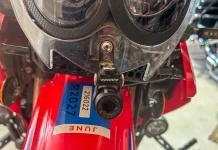Just as the two Gallery bikes in this issue revolutionized the street motorcycle world over 30 years ago, so too did the 1968 Yamaha DT-1 250 Enduro. The famous white-tanked bike was the first street-legal motorcycle that was also a capable, lightweight, reliable and powerful off-road machine. Yamaha’s newly dubbed “dual purpose” motorcycle introduced untold hundreds of thousands to the sport of motorcycle riding, and spawned an entirely new market segment.

In 1990, Suzuki worked to change that perception with its introduction of the DR350S. Now called “dual sport” bikes, the DR was lighter, better suspended and delivered superior handling compared to its predecessors. Of course, the Europeans were offering competitive machines, but their bikes were relatively crude for street use. Ten years later, Suzuki again redefined the dual sport paradigm with the DR-Z400S, a liquid-cooled, DOHC machine that enjoyed generous functional commonality with its off-road brother, the DR-Z400E.

Helmet: Simpson Horizon Eagle
Goggles: Scott No-Sweat IV
Jersey: AXO Team Issue
Gloves: AXO Padlock
Pants: AXO Phoenix
Boots: AXO RC6 (Click image to enlarge)
Photo rider: Jess McKinley
Photos by Don Williams
However, owing to the EPA and DOT obstacles, the DR-Z400S isn’t quite the motorcycle Suzuki surely wishes it could be. Emissions standards necessitate jetting so lean that the stock bike unpredictably surges and wheezes at steady throttle on the street, or over rough off-road terrain. Also, the stock tires are not focused for off-road performance. We believe a dual sport bike must be a capable dirt machine, while still retaining its street cred whether making a run to the local convenience store or the next state. To that end, we had Gary Jones Racing modify our DR-Z400S for greatly enhanced dirt performance, while keeping an eye on its pavement prowess. We did not want an unmanageable “racer with lights” result.
To resolve the inconsistent power delivery, Jones (a three-time AMA 250cc motocross champion) replaced the stock constant velocity carb with a 36mm Mikuni TM flat slide carburetor and, simultaneously, decongested the exhaust with a Yoshimura RS-3 stainless steel system. To ensure we would be welcome on our public lands, he installed a spark arrester and sound-reducing insert. Once Jones properly jetted the Mikuni, the motor ran flawlessly. It does not have the unconditional output of a racing engine; rather, it distributes power in controllable measures. The result is a perfect motor for trail riding, yet frisky enough to hold its own on pavement.

Weight is another enemy of the stock DR-Z400S, so we put the bike on a healthy diet. Centralizing mass upgrades handling, while reducing unsprung weight enhances suspension action. By fitting Braking Wave rotors and a rear Renthal aluminum sprocket, we accomplished the latter. The oversize front Wave rotor also improves deceleration, while three additional teeth on the rear sprocket prepare the DR-Z with off-road gearing, essential for tighter single-track trails.

Jones’ modifications have now set free a truly capable dual sport bike, previously obscured by layers of bureaucracy. Our DR-Z can now traverse virtually any terrain you would tackle with a full-on off-road bike—it conquered the double- black-diamond Snowy Trail in California’s Los Padres National Forest, and that is a ride no sane enthusiast would attempt without the right kind of machine under him. At the same time, we do not hesitate to ride the DR-Z on the 100 paved miles from our Malibu offices directly to the trailhead, and back. Suzuki may not market it as an “adventure bike,” but once the government-imposed limitations are lifted, the DR-Z400S is quite the explorer.

www.myspace.com/garyjonesracing





